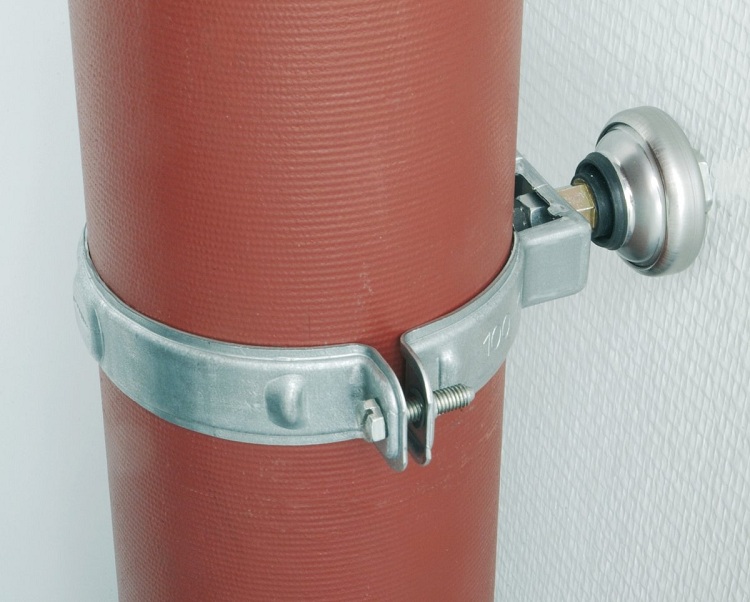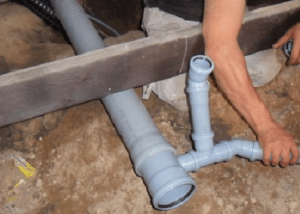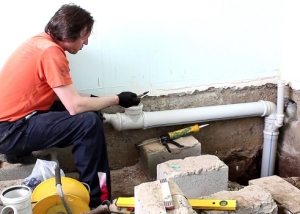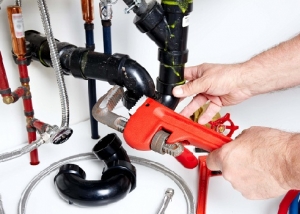Soundproofing sewage pipes in an apartment has become a massive problem with the proliferation of utilities laid using polymeric materials. In order to reduce the noise level coming from the sewer pipe to an acceptable level, you should understand the nature of its origin. This will allow you to choose the necessary tools to achieve a comfortable stay.

The noise from the water passing through the pipes is not only an annoying factor, but can also negatively affect human health
Content
Why plastic pipes are noisy
The fragility of cast iron products was one of the reasons for their displacement by polymer products. The reason for the fragility lay in the eutecticity of the material crystallized from the melt upon reaching the minimum required temperature. Eutecticity, which contributes to the absorption of vibration, as well as subsequent overgrowing from the inside, also explains the low noise of the cast-iron sewer.
Hum in plastic systems is generated by several sources:
- Atmospheric. Gusts of wind burst into the airspace of the sewer riser in contact with condensate accumulated on the inner walls or the working medium breaking through it.
- Vibrating. The pipe is in the building and perceives its vibrations.
- Resonant. Being an acoustic resonant system, a pipe cannot fail to transmit sounds at the slightest impact on it. The resonance generates vibrations of the structure itself, expressed in bending, compression / expansion, affecting the building as a whole and transmitting sound to the premises. The effect of vibration on the building generates infrasonic vibrations.
- Shock Drains when moving along the riser hit its walls. Or a poorly fixed product collides with an adjacent pipe or wall.
Among the factors due to the influence of which sound insulation of pipes becomes necessary are:
- material selected for the arrangement of the sewer system. The overwhelming majority of plastic elements do not possess sound-absorbing abilities and require additional operations;
- wall thickness and mass of products as a consequence of it. Thick-walled and massive elements easily absorb excessive decibels;
- location in relation to the walls. It is considered rational to have a sewage system in the floors, contributing to the absorption of vibrations. Unacceptable seems to be a riser in the interior ceilings and interroom walls;
- seal selection. It is possible to lower the noise level with rubber gaskets and foamed polyethylene, but the mounting foam, as an excellent conductor of sounds, is better not to use for insulation.
Sounds coming from sewer pipes are structural in nature, so their attenuation is done by:
- damping wall vibrations;
- exclusion of impact on the building structure itself.
Important! Since the main source of noise, including the most harmful one - infrasound, is the sewer riser, the greatest attention should be paid to its isolation.
When laying utilities, following the simplest requirements of building codes can reduce noise:
- obligatory reliable attachment of pipelines to building structures with a distance between attachment points not exceeding two meters;
- the implementation of fastening exclusively with standard elements, including an elastic rubber gasket;
- accurate sealing of holes in the ceilings. PP pipes are passed through polymer sleeves that are five to ten millimeters larger in diameter, filling gaps with non-combustible stone wool. Such material is suitable for products subject to thermal expansion.
Using silent pipes
Silent plastic pipes are obtained by adding mineral powder to the material, thereby achieving an effect similar to the eutectic inherent in cast iron. External signs of such pipes are:
- thickened walls;
- white color with red and green longitudinal stripes;
- the presence of the name, logo, details of the manufacturer, the amount of attenuation of sound in dB;
- considerable cost.
The three-layer construction consists of:
- the inner shell, the smooth polypropylene of which contains mineral inclusions. This allows you to achieve a soundproof effect, increase strength, chemical inertness;
- the main polypropylene layer, the addition of mineral particles to which blocks the sound of the working medium;
- hardened outer shell to protect from external influences.
Silent installation is carried out in compliance with the following recommendations:
- measurements are taken, pipes are cut off, the edges are cleaned with a file directed at an angle of 150º;
- surfaces of products are cleaned;
- o-rings are placed in strictly defined places;
- the bell is pushed onto the shaped part until it stops after applying silicone grease to its smooth surface;
- the pipe is pushed back a centimeter, providing a clearance in case of thermal expansion.
Note! It is possible to resort to the use of a floating mount only if necessary to ensure a longitudinal displacement of the pipe.
The mass distribution of silent pipes is hindered by two circumstances:
- Limited, in comparison with other polymeric products, the service life is twenty years.
- High price.
Sewer pipe insulation
Refusing to purchase expensive silent pipes, it is quite possible to make a soundproofing of the sewer riser without resorting to the help of third-party specialists.
When selecting the material, it is worth paying attention to the decibel absorption declared by the manufacturer and the presence of a rigid external side, which extends the duration of operation.
For high-quality sound insulation, the use of:
- foamed polyethylene. The use of this material allows you to simultaneously achieve thermal insulation and prevent the formation of condensate, which causes mold and fungus;
- polyurethane foam. It is especially recommended for use on a cross or wiring site.;
- foam shell. Suitable only in a direct section;
- soundproof tape applied by a large number of layers;
- roll insulation, proven means applied without the formation of airs between the layers.
The use of mineral wool and polyurethane foam as insulation is strongly not recommended. Mineral wool - insulation, the use of which in residential premises should be excluded, and the mounting foam perfectly transmits sound.
Wrapping the pipe with roll insulation and reducing the edges butt, tightly fixed with three layers of construction tape. Fixing strength can be increased by using wire winding or plastic fasteners. An increase in the weight of the structure will positively affect the level of sound resonance.
Helpful advice! If possible, after completing the insulation, it is worth enhancing the effect by overlaying the structure with a plasterboard box or plastic panels filled with a sealant. When installing the box, you should leave access to all the connections on the sewer riser in case of an emergency or repair work.

The pipe is covered with material along the entire length, and the insulation should fit as tightly as possible
How is a fan pipe soundproofed?
The fan pipe in the toilet, each visit of which is accompanied by a powerful sound accompaniment, can be changed to silent. Or, independently conduct sound insulation with vibration damping and sound-absorbing materials with a self-adhesive base and a small set of improvised tools.
Operational work is carried out in the following order:
- The surface of the pipe is degreased and coated with a vibration damping material that dampens the penetration of structural noise.
- By thorough rolling, gluing with the surface of the pipe is achieved.
- A sheet of sound-absorbing material, such as foamed polyethylene, cut to the desired size, is superimposed and glued on top. Using it together with vibration damping material will achieve maximum efficiency, eliminating even the sound of gurgling or gurgling water.
By choosing the right materials for the sound insulation of the fan pipe, it will not be too difficult to achieve the desired result.
In order to protect the apartment from unwanted noise produced by the sewer system, it is advisable to carry out work on their isolation together with the neighbors so that they are conducted throughout the riser. This will allow to achieve the full effect of the operations performed and will bring significant benefits to all residents. And the level of costs attributable to each apartment owner individually will be significantly lower if they join forces to achieve a common goal.
It happens that it is not possible to achieve the planned level reduction immediately. The reasons, as a rule, lie in:
- refusal of rubber gaskets when attaching clamps;
- rubber seals not installed in the ceiling;
- loose fit of soundproofing materials to pipes;
- erroneous choice of sound-absorbing material.
Accurate work using high-quality modern soundproofing materials can reduce the noise level produced by the sewer system to a completely comfortable one. Then a stay in the apartment will not be overshadowed by a sewer constantly reminding of itself with noise.








